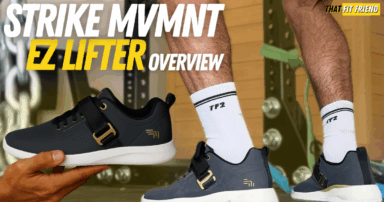The split squat and lunge are both lower body staples in most workout programs. If your goal is building lower body strength, size, and power then there’s a good chance you’re regularly split squatting or lunging.
As a coach, I love split squats and lunges because there’s so much variety that comes along with them. If you’ve ever wondered what the differences are between lunges versus split squats and how to use them efficiently, then this article is for you.
If I’m working with beginners, I’ll typically start them with split squats because there’s less of a balance component, then progress them into various lunges depending on how fast they pick on single-leg squat work.
Lunges Versus Split Squat Differences
In this article, I’ll cover different split squats and lunge variations, but for this differences section, I’m going to be comparing the traditional split squat and lunge from an overview context.
Difference 1: Movement Execution
The first and biggest difference between split squats and lunges is how you’ll execute each exercise. In the split squat, regardless of the variation you’re using, the feet will remain static and in one position throughout the entirety of your set.
With lunges, regardless of the variation you’re using, the feet will be moving each rep. For example, you’ll either be stepping forward, backward, laterally, or walking when performing lunges and the feet will be moving.
When in doubt, remember that the split squat involves static and anchored feet while the lunge will be more dynamic and involve some variation of a step.
Difference 2: Balance and Coordination Demands
The second difference to keep in mind between the lunge versus split squat is the balance and coordination demands each exercise will require. Since one exercise is static and the other is dynamic this will change baseline exercise requirements.
The split squat will typically require less of a balance requirement compared to a lunge. With lunges, regardless of the variation, reps can and typically differ slightly throughout sets based on things like changes in stride length when fatigue sets in.
There’s also a deceleration component in lunges that differs them from split squats regarding their coordination and balance requirements.
For example, you’ll have to slow your body weight down at a different rate through the eccentric or lowering portion of reps when performing lunges. Changes and minor discrepancies in form throughout reps can also shift the deceleration component.
Deceleration will remain relatively static and consistent in split squats since this exercise and its variants have less of a dynamic component.
Another thing to keep in mind, which extends off of deceleration, is that split squats and lunges will typically have different rates of momentum used and required during sets and reps.
Difference 3: Who Each Can Be Best For
While there is a lot of nuance to programming split squats versus lunges, one difference to keep in mind when using these exercises is that one typically requires a little less skill than the other.
Generally speaking, the traditional split squat will be the most beginner-friendly option among these two exercises, especially if the goal is teaching someone how to perform single-leg squats and other exercises.
Lunges can also be great for beginners, but if the goal is teaching single-leg squat mechanics, then a split squat will usually be your best bet as it’s easier to teach, control, and add constraints to.
For example, you can have a beginner or an older client perform a split squat while holding onto a wall for additional stability support. This difference can make the split squat a little more beginner-friendly than the lunge, and obviously, context is always needed here.
Over the course of my coaching career below is how I’d rank split squats versus lunges in the context of their skill level from easy to more difficult.
- Split Squat Flow Easy to Hard: Traditional split squat, front-foot elevated split squat, rear-foot/Bulgarian split squat
- Lunge Flow Easy to Hard: Reverse lunge, forward lunge, walking lunge (non-continuous), lateral lunge, continuous walking lunge.
Note, there can be some discrepancies above with how certain lifters and athletes interpret the “easiness” of each exercise. This can be based on a multitude of factors like training history, mobility levels, training age, and much more.
Lunge Versus Split Squat Muscles Worked
The muscles worked with split squats versus lunges will vary depending on the variation that you’re performing. Below I’ll provide an overview of different split squat and lunge variations along with the muscles each works.
Coaching Note: You can further manipulate the muscles you’re training with the variation of lunges and split squats that you’re using by playing with joint angles and setup.
Lunges Versus Split Squats Benefits
There are multiple benefits of using split squats and lungs in your workout and these benefits will ebb and flow based on what you’re trying to accomplish with each exercise.
Below I’m going to cover three benefits of split squats and lunges, but note, that different variations will come with slightly different benefits based on how you’re programming them.
Benefit 1: Great for Building Leg Strength
The first benefit of split squats and lunges is that they can be fantastic for building lower body strength. Split squats and lunges and all of their variations will strengthen your glutes, quads, adductors, calves, and more to different degrees.
If your goal is building your quads and glutes then it can be useful to use split squats and lunges in your workout program. As you get more specific with your goals, then you program variations that will more directly hit the muscles you want to grow most.
For example, the traditional split squat can be great for building the quads, but if you really want to focus and isolate the quads, then using a Bulgarian split squat would be a good strategy.
Benefit 2: Awesome for Packing On Lower Body Mass
Another benefit of lunges and split squats is that they can be awesome for building lower body mass. When I’m trying to increase the size of my quads and glutes few exercises do as good of a job as lunges and split squats.
I also routinely use lunges and split squats to help clients build their legs when their goals revolve around lower body hypertrophy. I’d suggest exploring various lunge and split squat variations to see if you respond better to one over the other.
For example, I respond really well to barbell walking lunges when I want to build my glutes, and when my goal is building my quads I’ll use a Bulgarian split squat with weightlifting shoes to double-down on hammering my quads.
If you’re struggling to pack on lower body mass and you’re using things like barbell squats and machines, try adding more split squats and lunges into your program to see if you notice a difference.
In my opinion, lunges and split squats can be fantastic in this context, too, because they’re less demanding from a neural and fatigue standpoint so you can push them hard without accumulating too much fatigue.
Benefit 3: Real-Life and Sports Performance Carryover
The final benefit worth noting with lunges and split squats is that they can have a positive carryover to the real world and sports performance. Both exercises will help you improve your balance and coordination.
Improving balance and coordination can be useful as we age to prevent falling and for promoting better movement overall on a day-to-day basis, along with contexts where we need to be strong while balancing on one leg.
On top of this, lunges can have an additional benefit for improving how we decelerate on one leg. This is useful for sports where you’re going to be cutting and decelerating from sprints, for example.
Frequently Asked Questions (FAQ)
Q:What is the difference between split squat and lunge?
Q:Are split squats better than lunges?
Q:Are split squats the same as lunges?
Q:Are lunges better than split squats for building muscles?
Takeaway Thoughts
The split versus the lunge is an epic showdown when it comes to programming strategy. Both of these exercises are great for building lower body strength and for packing on mass.
If you’re considering using lunges and split squats to help you accomplish your goals, then I’d suggest reverse engineering your approach. Consider what exactly you’re trying to accomplish, then use the variation that best suits your needs.
There is a ton of nuance that exists with lunges and split squats especially when it comes to programming.
If you have additional questions about lunges versus split squats, drop a comment below or reach out to me personally via Instagram (@jake_boly or @that_fit_friend).
























Add a Comment